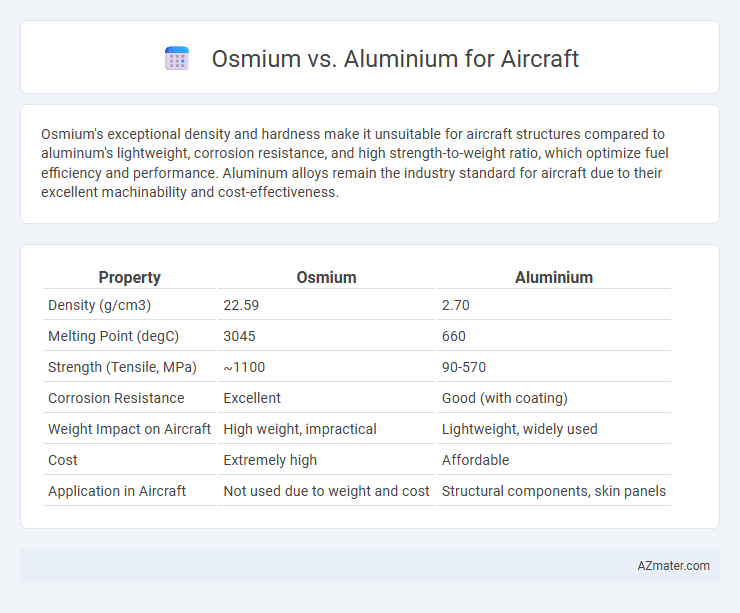Osmium's exceptional density and hardness make it unsuitable for aircraft structures compared to aluminum's lightweight, corrosion resistance, and high strength-to-weight ratio, which optimize fuel efficiency and performance. Aluminum alloys remain the industry standard for aircraft due to their excellent machinability and cost-effectiveness.
Table of Comparison
| Property | Osmium | Aluminium |
|---|---|---|
| Density (g/cm3) | 22.59 | 2.70 |
| Melting Point (degC) | 3045 | 660 |
| Strength (Tensile, MPa) | ~1100 | 90-570 |
| Corrosion Resistance | Excellent | Good (with coating) |
| Weight Impact on Aircraft | High weight, impractical | Lightweight, widely used |
| Cost | Extremely high | Affordable |
| Application in Aircraft | Not used due to weight and cost | Structural components, skin panels |
Introduction to Osmium and Aluminium in Aviation
Osmium, a dense and rare transition metal, offers exceptional strength and high corrosion resistance but is rarely used in aviation due to its weight and cost. Aluminium, a lightweight and abundant metal, dominates aircraft construction because of its excellent strength-to-weight ratio, corrosion resistance, and ease of fabrication. The contrast in density and material properties between osmium (22.59 g/cm3) and aluminium (2.70 g/cm3) highlights why aluminium remains the preferred choice in aerospace engineering.
Physical Properties Comparison
Osmium boasts an extraordinary density of 22.59 g/cm3, significantly surpassing aluminium's lightweight 2.70 g/cm3, making it far less practical for aircraft weight considerations. Aluminium offers superior malleability and corrosion resistance essential for aircraft durability and structural integrity under varied environmental conditions. The high melting point of osmium at 3045 degC contrasts with aluminium's 660 degC but limits osmium's utility in lightweight aerospace applications due to its excessive mass and brittleness.
Weight and Density Considerations
Osmium, with a density of approximately 22.59 g/cm3, is significantly heavier than aluminum, which has a density near 2.70 g/cm3, making aluminum vastly preferable for aircraft construction where weight reduction is critical. The lower density of aluminum contributes to improved fuel efficiency and enhanced payload capacity in aerospace applications. Despite osmium's exceptional hardness, its substantial weight makes it impractical for most structural components in aircraft design, where lightweight materials like aluminum alloys dominate.
Strength and Durability Factors
Osmium exhibits exceptional density and hardness, making it one of the strongest and most durable metals known, with a tensile strength significantly higher than aluminum. However, its extreme weight (around 22.59 g/cm3) severely limits practical use in aircraft where lightweight materials are critical for performance and fuel efficiency. Aluminum alloys, with a density of approximately 2.7 g/cm3, provide a balanced combination of strength, corrosion resistance, and durability, making them ideal for aircraft structural components despite osmium's superior hardness.
Corrosion Resistance in Aircraft Materials
Osmium exhibits exceptional corrosion resistance due to its dense, stable crystal structure and high resistance to oxidation, making it highly durable in harsh environments. Aluminium, widely used in aircraft manufacturing, offers good corrosion resistance through its natural oxide layer, but it is prone to corrosion in saline or high-humidity conditions unless properly treated or coated. While osmium's superior corrosion resistance is advantageous, its rarity and weight make aluminium the more practical and cost-effective choice for aircraft materials where corrosion resistance is balanced with lightweight properties.
Cost and Availability Analysis
Osmium is significantly more expensive and rare compared to aluminum, which is abundant and widely accessible in the aerospace industry. The high cost and scarcity of osmium make it impractical for aircraft manufacturing, whereas aluminum offers an optimal balance of cost-efficiency and availability. Aluminum's lightweight properties and established supply chain ensure its dominance as the preferred metal for aircraft structure and components.
Manufacturing and Machinability
Osmium's extreme density and hardness make it highly challenging to machine, limiting its use in aircraft manufacturing where precision and ease of shaping are critical. Aluminium offers superior machinability with low tool wear and fast processing times, making it the preferred choice for complex aircraft components. Manufacturing with aluminium benefits from its lightweight, corrosion resistance, and cost-effectiveness, enabling efficient production and reduced overall aircraft weight.
Environmental Impact and Sustainability
Osmium, a rare and dense metal, has a significantly higher environmental impact due to its energy-intensive extraction and limited availability compared to aluminum, which is abundant and more recyclable. Aluminum's lightweight nature and high recyclability reduce aircraft fuel consumption and carbon emissions, making it a more sustainable choice for aviation. The widespread adoption of aluminum alloys supports circular economy initiatives, minimizing environmental footprint throughout the aircraft lifecycle.
Safety and Performance in Flight
Osmium, one of the densest metals, offers exceptional hardness and resistance to wear, but its high density makes it impractical for aircraft where weight reduction is crucial for safety and performance. Aluminium remains the preferred material in aerospace due to its lightweight properties, high strength-to-weight ratio, excellent corrosion resistance, and ability to withstand cyclic stresses during flight, directly enhancing fuel efficiency and maneuverability. The safer and more efficient performance of aluminium alloys, such as 7075 and 2024, supports their widespread use in aircraft fuselage and structural components.
Future Prospects for Aircraft Material Innovation
Osmium's exceptional density and hardness present unique opportunities for future aircraft material innovation, potentially enhancing structural strength and durability in critical components. Aluminium remains a cornerstone in aerospace manufacturing due to its lightweight and corrosion resistance, but advances in osmium alloy composites could pave the way for hybrid materials that balance weight and resilience. Emerging research on nanoscale osmium integration aims to revolutionize aircraft performance by combining osmium's mechanical advantages with aluminium's efficiency in fuel consumption.

Infographic: Osmium vs Aluminium for Aircraft
 azmater.com
azmater.com